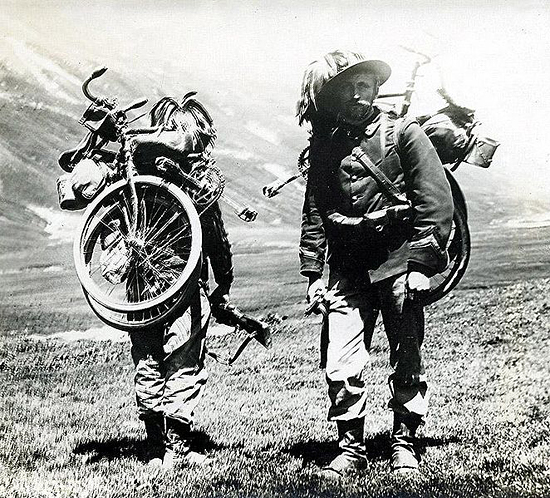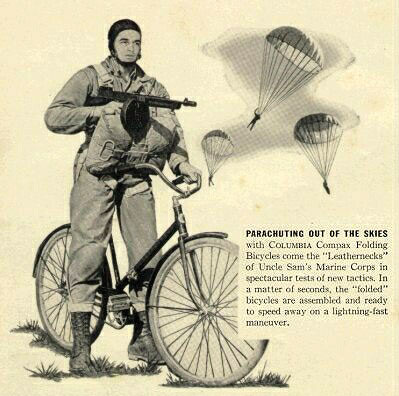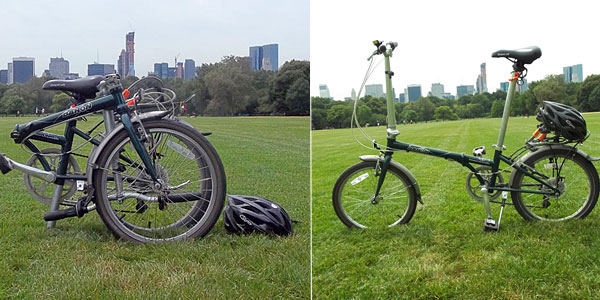Folding Bicycles
by Andrew Boyd
Today, altered shapes. The University of Houston's College of Engineering presents this series about the machines that make our civilization run, and the people whose ingenuity created them.
The question of when the first bicycle was built isn't easily answered. First we must decide on what constitutes an actual bicycle. But if we agree it must have two wheels and a means of pedaling, the bicycle's been with us only since the mid to late 1800s. We went from the first bicycle to the Wright Brothers' first airplane in less than fifty years.
Bicycles experienced tremendous growth in the late 1800s as designs improved and the public discovered their utility. One of many improvements was the ability to fold a bicycle, making it more compact for storing. But folding offered other advantages that were quickly recognized by a group we don't normally associate with bicycles — the military.
Military leaders took a keen interest in bicycles from early on. An infantryman could cover more territory with less effort when armed with a bicycle. By the time of the First World War, armed forces throughout the world employed bicycle units.
In a sense, bicycles were seen as replacing the horses used by cavalry units. Bicycles didn't require the care and feeding of horses. But they also couldn't travel some terrain that horses could; terrain that was too rocky or too muddy. If a bicycle could be folded into a more compact form, a soldier could carry it on his back when necessary.

Another advantage of folding bicycles was that they proved well suited for dropping from airplanes. With or without a parachute, an encounter with the ground comes as quite a shock. Folding bicycles proved far sturdier than their non-folding counterparts in bike-meets-earth collisions, and during the Second World War thousands of folding bicycles were dropped into battlefields along with paratroopers.

Today, folding bicycles are being used in a new type of war — war on the urban terrain. As city planners seek to encourage greener modes of transportation, bike paths are popping up everywhere in densely populated cities. For bicycle owning apartment dwellers, the lack of a garage and the potential for theft make the hallway closet an ideal parking spot. Folding bicycles enable longer commutes to work, since they can be taken onto light rail cars, subways, and busses.
In response to the need, engineers have risen to the challenge. From smaller wheels to lighter materials to intricately designed hinges, folding bicycles are taking the streets by storm. What was once an urban oddity is now an increasingly common sight. In some circles, folding bicycles are as fashionable as iPhones.
Heralding from a profession once defined by overstuffed pocket protectors, I've never been much in tune with fashion. But when it comes to a good engineering solution, I'm happy to jump on the bandwagon — or the folding bicycle.
I'm Andy Boyd at the University of Houston, where we're interested in the way inventive minds work.
Notes and references:
Special thanks to Manhattan residents Richard and Kiki Bennett for bringing the growth of folding bicycles to my attention.
For a related episode, see THE BICYCLE.
Bicycle Infantry. From the Wikipedia website: https://en.wikipedia.org/wiki/Bicycle_infantry. Accessed August 7, 2012.
Folding Bicycle. From the Wikipedia website: https://en.wikipedia.org/wiki/Folding_bicycle. Accessed August 7, 2012.
The History of the Folding Bike. From the Folding Cyclist website: http://www.foldingcyclist.com/folding-bike-history.html. Accessed August 7, 2012.
The picture of the First World War soldiers and the paratrooper are in the public domain as a result of their age. The pictures of the cyclist and the folding bicycle are care of Richard and Kiki Bennett.
This episode was first aired on August 9, 2012

